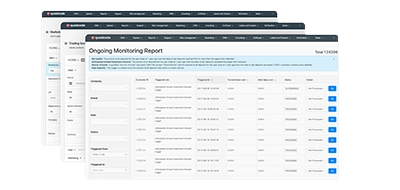Back
Contents
Бессрочные фьючерсы. Что это такое и как они работают?


Demetris Makrides
Senior Business Development Manager

Vitaly Makarenko
Chief Commercial Officer
В отличие от традиционных фьючерсных контрактов, бессрочный фьючерсный контракт не имеет даты истечения срока действия. Трейдеры могут удерживать позицию столько, сколько захотят. Более того, бессрочные фьючерсные контракты торгуются по цене, равной или близкой к спотовой цене.
Основные выводы:
- Что такое бессрочный фьючерсный контракт?
- В чем разница между вечными и традиционными фьючерсами?
- Плюсы и минусы бессрочных фьючерсов.
- Как правильно торговать бессрочными фьючерсами?
- Что лучше — бессрочные фьючерсы или спотовая торговля?
Определение бессрочных контрактов
Под термином «бессрочный фьючерсный контракт» в финансовом мире понимают производные торговые инструменты, которые не имеют срока действия; именно поэтому держатели таких контрактов могут спекулировать на ценах неограниченное время.
Первое упоминание о таком типе фьючерсного контракта появилось в 1993 году в статье Роберта Шиллера. Однако сам инструмент появился гораздо позже, в 2016 году. BitMEX стала первой торговой площадкой, позволившей своим клиентам покупать и продавать бессрочные опционы за биткоин.
В настоящее время бессрочные фьючерсные контракты в основном относятся к торговле криптовалютой, но этот инструмент может также включать в себя другие базовые активы. ресурсы как индексы или товары.
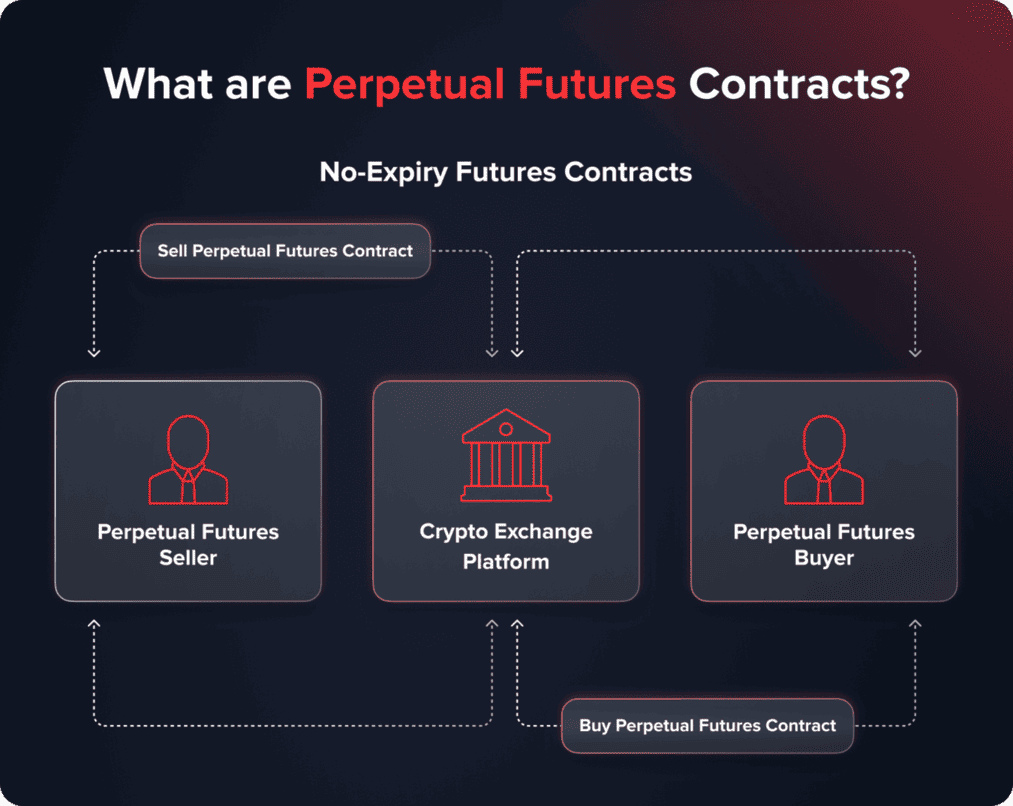
Вечный Фьючерсы против традиционных фьючерсов. В чём основные различия?
Давайте подробнее рассмотрим различия между бессрочными и традиционными фьючерсными опционами.
Чтобы лучше понять вышеперечисленные различия, необходимо подробно остановиться на каждом критерии.
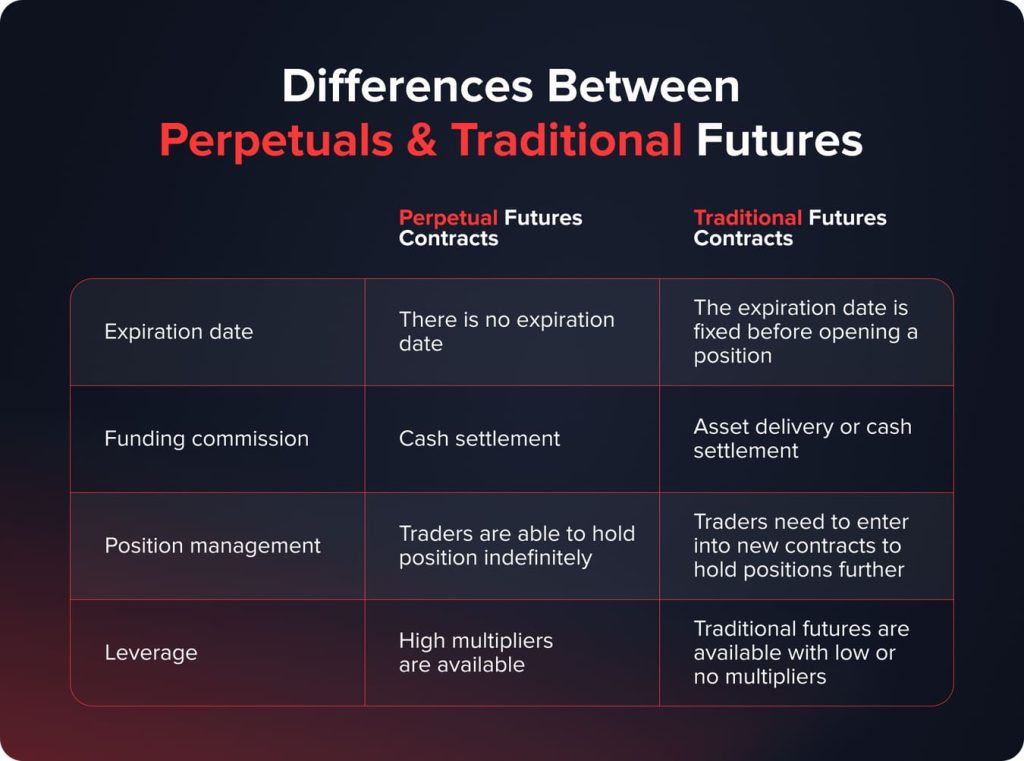
Дата окончания срока
В этом и заключается главное отличие бессрочных контрактов от традиционных. При покупке или продаже традиционного фьючерсного контракта дата его истечения заранее определена (14 дней, 30 дней, 180 дней и т. д.). Что касается бессрочных контрактов, вы можете удерживать позицию без каких-либо ограничений, сколько захотите.
Комиссия по финансированию
Следующее различие между двумя типами фьючерсных контрактов — это финансирование. Цены базовых активов традиционных фьючерсов автоматически соответствуют спотовым ценам по мере приближения даты экспирации. Бессрочные контракты не включают такой механизм, поэтому финансирование выполняет функцию балансирующего фактора.
Под комиссией за финансирование (ставкой финансирования) трейдеры понимают периодические платежи между держателями длинных и коротких позиций. Этот инструмент мотивирует менее популярную сторону поддерживать баланс между ценами бессрочных и спотовых опционов.
При положительной ставке финансирования цена контракта становится выше спотовой. В такой ситуации держатели длинных позиций вынуждены платить ставку финансирования в пользу держателей коротких позиций. Отрицательная комиссия финансирования означает, что цена контракта ниже спотовой, и держатели коротких позиций платят в пользу держателей длинных позиций.
You may also like

Примечание! Ставка фондирования не фиксирована и зависит от разницы между ценой контракта и спотовой ценой. В некоторые моменты не рекомендуется открывать позиции из-за исключительно высоких ставок фондирования.
Давайте проверим, как на практике работает комиссия за финансирование по бессрочному контракту.
- Binance обычно взимает комиссию за финансирование в размере 0,01%, когда на рынке не наблюдается резких ценовых колебаний.
- Трейдер открывает длинный бессрочный контракт общим объёмом 100 USDT (примерно $100) с кредитным плечом 1:10 (10x). Маржа составляет 10 USDT ($10).
- Положительная комиссия означает, что ему необходимо оплатить финансирование в пользу шорта. Комиссия взимается три раза в день. При этом размер комиссии умножается на выбранное кредитное плечо. 0,01% становится 0,1% (0,01 * 10).
- Таким образом, держатель долгосрочного бессрочного контракта платит комиссию за финансирование в размере 0,01 доллара три раза в день.
Управление позициями
Владельцы бессрочных контрактов могут сохранять свои длинные/короткие позиции сколь угодно долго. Традиционные фьючерсные контракты имеют предопределённую дату истечения срока действия, и владельцы не могут на неё как-либо повлиять. Единственный вариант — закрыть одну позицию и открыть другую фьючерсную позицию с более длительным сроком действия.
Использовать
Бессрочные контракты доступны с гораздо более высокими мультипликаторами, чем традиционные фьючерсные контракты. Ведущие биржи позволяют своим трейдерам использовать рычаги up to 1:125. On the one hand, such multipliers open brand new opportunities for traders. On the other hand, using high рычаги implies higher risks as well.
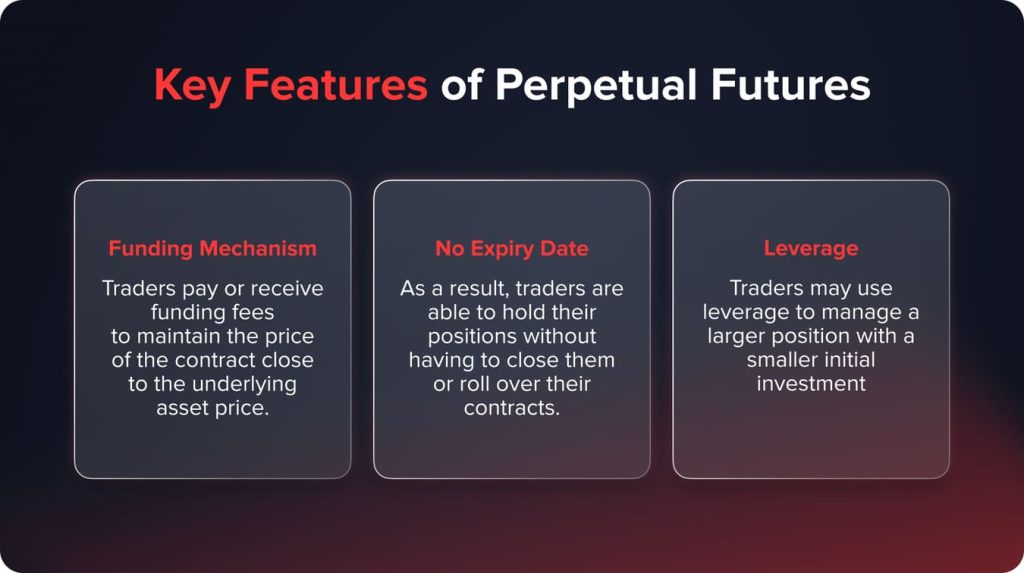
Плюсы и минусы бессрочных фьючерсов
Популярность бессрочных фьючерсных контрактов набирает обороты. По данным Block, общий объём рынка бессрочных криптовалютных контрактов превышает 200 миллиардов долларов. Вот основные преимущества бессрочных контрактов:
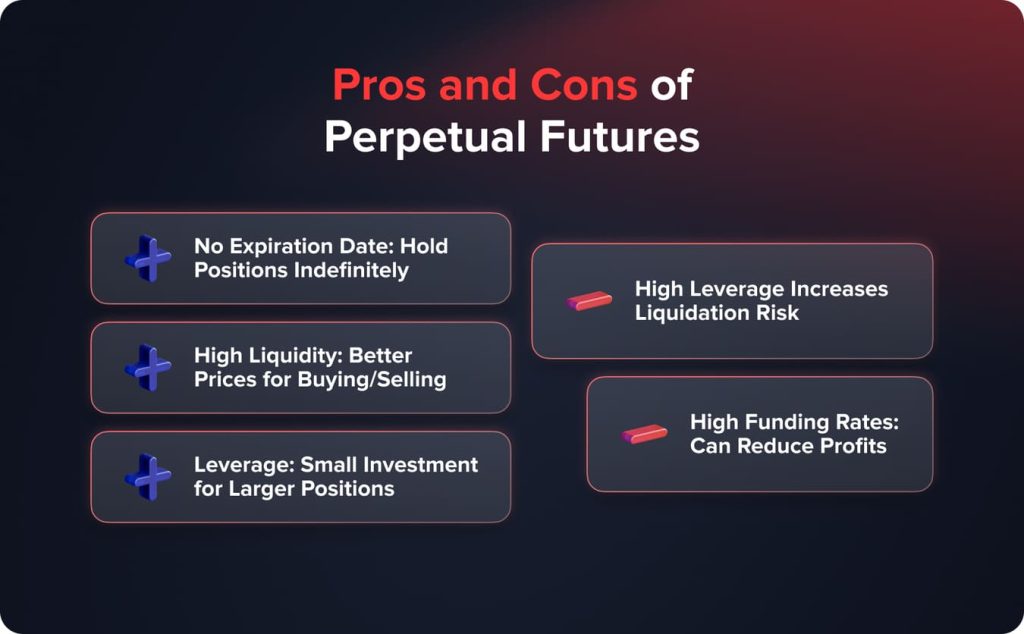
- Бессрочные опционы не ограничены сроком экспирации. Ключевая особенность такого типа контракта — это его главное преимущество. Трейдеры могут удерживать свои позиции сколь угодно долго, что позволяет им легко адаптировать свои стратегии к изменениям рынка.
- Бессрочные фьючерсные контракты характеризуются наивысшей ликвидностью. Во многих случаях ликвидность бессрочных контрактов даже выше, чем на спотовом рынке. Трейдеры могут получить максимально возможную цену при покупке и продаже бессрочных контрактов.
- Такой инструмент доступен с более высокими мультипликаторами, поэтому трейдеры могут открывать позиции на больший капитал, инвестируя небольшие суммы. Например, кредитное плечо 1:100 (100x) позволяет инвестировать всего 10 долларов и открыть позицию на 1000 долларов.
Если брать только преимущества, бессрочные контракты кажутся идеальным инструментом для трейдера. Однако есть и подводные камни. Каковы основные недостатки этого торгового инструмента?
- Высокие мультипликаторы предоставляют трейдерам лучшие возможности, поскольку они могут открывать позиции на большие суммы, инвестируя меньше капитала. В то же время кредитное плечо значительно увеличивает риски, особенно на рынке криптовалют. При использовании мультипликатора 1:100 изменение цены актива на 1% в противоположном направлении приводит к ликвидации позиции. Начинающим трейдерам не рекомендуется использовать мультипликаторы выше 1:10.
- Ставки финансирования могут быть исключительно высокими в зависимости от определённых рыночных условий. В «спокойные» периоды ставки финансирования не оказывают существенного влияния на ваш капитал, но резкие колебания цен, происходящие довольно часто, могут «съедать» до 1–2% вашей позиции три раза в день. Таким образом, владение бессрочным опционом может быть убыточным.
Таким образом, бессрочные фьючерсные контракты имеют как преимущества, так и недостатки. Такой инструмент весьма привлекателен для трейдеров, особенно на рынке криптовалют. Однако, прежде чем торговать бессрочными контрактами, необходимо понимать риски и избегать их или минимизировать.
Что такое торговля бессрочными фьючерсами? Лучшие стратегии
При торговле бессрочными фьючерсами трейдерам необходимо понимать, какие стратегии применять. Вот список наиболее распространённых торговых подходов к торговле бессрочными фьючерсами:
Спекуляция
Эта торговая стратегия так же проста, как открыть дверь. Трейдеры используют различные инструменты технического и фундаментального анализа, чтобы понять, в каком направлении будет двигаться цена актива. Основываясь на этом понимании, трейдер открывает длинную или короткую позицию. Спекуляция эффективна как для краткосрочной, так и для долгосрочной торговли.
Следование тренду
Стратегия эффективна для краткосрочной торговли (скальпинг, внутридневная торговля). Используя технические инструменты, трейдерам необходимо определить текущий рыночный тренд и его силу. Затем они открывают длинные и короткие позиции соответственно. Кроме того, сильный тренд позволяет трейдерам использовать высокие мультипликаторы для увеличения возможной прибыли.
Хеджирование
Бессрочные опционы широко используются в качестве инструментов хеджирования. Трейдеры открывают одну позицию на спотовом рынке, а затем хеджируют её бессрочным опционом в противоположном направлении. Например, трейдер держит Ethereum на спотовом рынке и открывает короткий бессрочный контракт для хеджирования своей позиции.
You may also like

Арбитраж
Трейдеры могут использовать разницу в цене между спотовым рынком и бессрочными контрактами для получения прибыли. Такая стратегия подразумевает одновременную покупку актива на одном рынке и продажу того же актива на другом. Например, вы нашли разницу в цене биткоина. Купите BTC на спотовом рынке и продайте на рынке бессрочных контрактов, или наоборот.
Финансирование арбитража
Стратегия подразумевает, что трейдеру необходимо определить разницу между ставками финансирования на двух торговых платформах. Например, одна криптовалютная биржа предлагает 0,05% по бессрочным контрактам на биткоин, а другая — 0,01% по тому же инструменту. Трейдеры открывают два контракта: длинный и короткий, чтобы получить прибыль от разницы. При этом необходимо учитывать комиссии за покупку/продажу контрактов.
Бессрочные фьючерсы против спотовых. Что лучше?
В чём главное преимущество бессрочных фьючерсов? Как мы уже упоминали, у них нет срока действия. В то же время, на спотовом рынке трейдеры могут удерживать свои позиции сколь угодно долго. В чём основные отличия спотового рынка от бессрочных фьючерсов, и какой инструмент лучше?
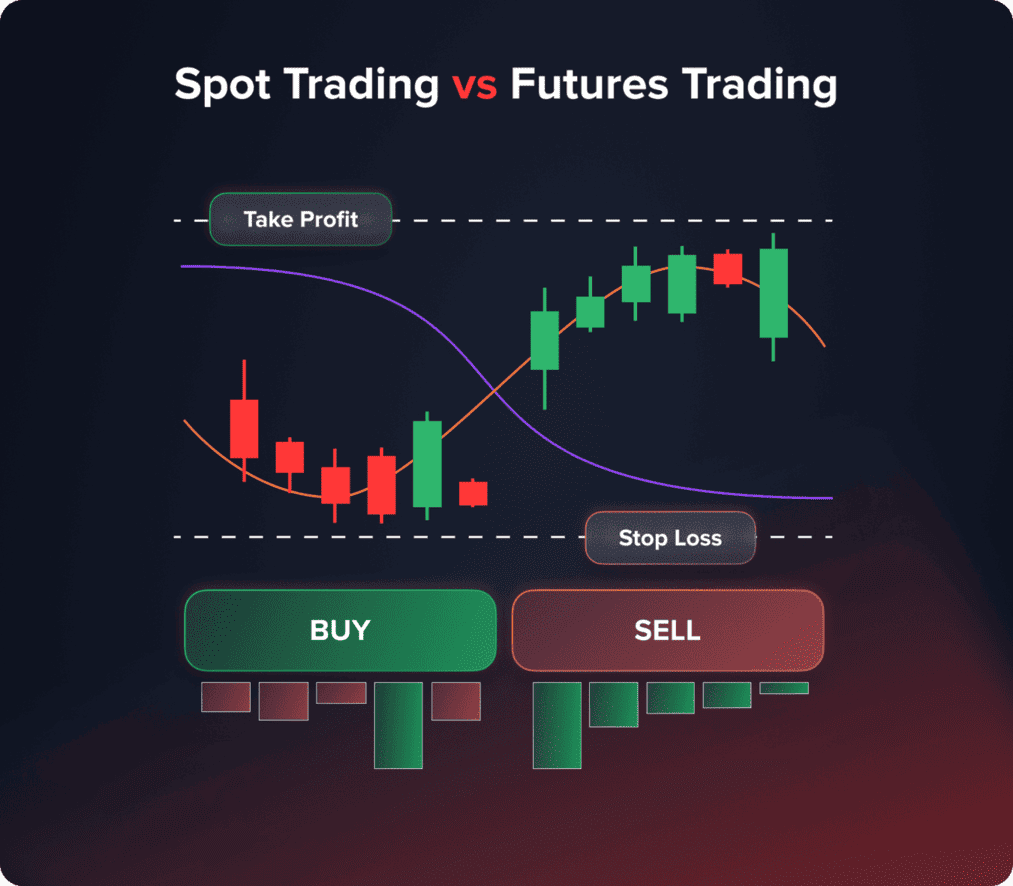
Бессрочные фьючерсы против спотовых. Преимущества бессрочных фьючерсов:
- Бессрочные контракты доступны с мультипликаторами. Некоторые биржи предлагают кредитное плечо до 1:125, поэтому трейдеры могут использовать меньший капитал для получения большей прибыли.
- Бессрочные опционы широко используются в различных стратегиях, таких как хеджирование и арбитраж.
- Бессрочные фьючерсные контракты подходят всем стилям торговли (как краткосрочным, так и долгосрочным).
Бессрочные купоны против спотовых. Преимущества спотовых купонов:
- Трейдеры не платят комиссии за финансирование, поэтому резкие движения рынка на них не влияют.
- Риск ликвидации, возникающий при использовании трейдером кредитного плеча, отсутствует.
Поэтому сложно ответить, какой инструмент лучше. И бессрочные контракты, и спотовые позиции имеют свои сильные стороны, и трейдеры используют их по-разному.
Итог
Бессрочные фьючерсные контракты предоставляют трейдерам возможность спекулировать на будущих ценах активов, не ограничиваясь датой истечения срока действия. Кроме того, бессрочные контракты позволяют трейдерам использовать кредитное плечо и получать более высокую прибыль при меньших капиталовложениях.
По сравнению со спотовым рынком и традиционными фьючерсами этот инструмент имеет как преимущества, так и недостатки. Трейдеры широко используют бессрочные опционы в спекулятивных стратегиях, хеджировании, следовании за трендом и арбитраже.
FAQ
Такой торговый инструмент широко используется в различных стратегиях и не имеет срока действия, поэтому трейдеры могут удерживать свои позиции неограниченное время.
Финансирование — это комиссия, уплачиваемая держателями длинных или коротких позиций, которая помогает поддерживать баланс между ценой бессрочного контракта и ценой базового актива на спотовом рынке.
Профессиональные трейдеры используют бессрочные опционы для следования за трендом, хеджирования, спекуляций и различных видов арбитража.
Обновлено:
19 декабря 2024 г.
